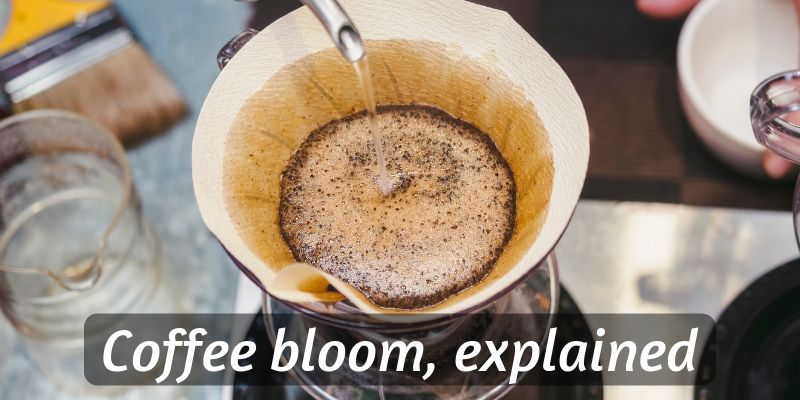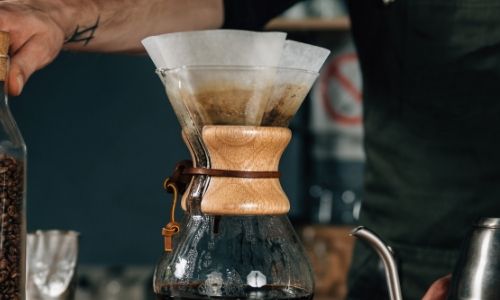Coffee bloom is something you might've heard about before, but aren't really sure what it means. I sure didn't until I really got into coffee.
Chances are you've already seen your coffee blooming at times, but didn't know exactly what you were looking at. Let me help you out.
Table of Contents
What is coffee bloom ?
Coffee bloom is the term given to the foam ground coffee makes when it touches hot water. If you use pour-over or French press, then you've already seen this.
The same happens when making Turkish coffee, and it's also part of the reason crema happens on an espresso.
Coffee is always meant to bloom. If your ground coffee does not bloom, or gives a weak performance, then it's a sign it might be stale, and will produce a weak cup.
Why does coffee bloom ?
Coffee blooms because once it goes through the roasting process - so from green coffee to roasted coffee - the natural gasses within the beans are easier to release.
Some of them are released once the coffee is ground, but most of them are released when you add hot water to them. This happens because the CO2 trapped within the ground coffee finds its way out much easier when the beans expand (heat).
Why does coffee need to bloom before you make a cup ?
You need to let your coffee bloom before you actually make your cup of coffee. That is, once the coffee makes its foam, allow it to settle for about half a minute, and then continue brewing.
This is because the CO2 in the bloom lends a sour, acidic note to your cup of coffee, and no one really likes that.
It's easier to do this with manual methods of making coffee - pour-over, Turkish, French press - than the automated or semi automated versions, because you can stop at any point you need to.
I'll get into how to actually do this a few paragraphs later. Until then, know that not letting your coffee bloom won't have disastrous consequences.
It'll still be drinkable, and if you're adding milk, sugar, and other flavorings to your coffee then chances are you won't even notice the slight acidity.
If you're using a Moka pot, where you can't really stop the process and let the coffee bloom as it needs, this is what happens to your coffee pretty much every time.
Should you be blooming your coffee or not ?
This really depends on who you are.
As in,if you generally flavor your coffee with milk and sugar - I do - then you might not care if the coffee has been left to rest after blooming.
But if you drink black coffee and only black coffee, and are a big fan of the multitude of flavors Arabica varieties can bring, then yes. You should be blooming your coffee, and only brewing after it's had its rest.
Anyone else might not notice a clear difference.
What a coffee bloom looks like, and what it says about the coffee
Alright, let's discuss what a coffee bloom looks like. It's going to help you determine whether your coffee is fresh or stale. In the cases where you forget to let the coffee bloom, it'll be easy to figure out whether it bloomed or not. At least with drip coffee makers.
So once you've added your ground coffee to the hot water, you should see it instantly produce a thick layer of foam, a light brown. Not a thick and dense as espresso crema, but definitely lots of tiny bubbles. It can sometimes get to half an inch thick.
If you're making Turkish coffee this is what you'll see, and you'll also notice it's coming straight at you. You'll need to pull the ibric off the heat.
Back to blooming, you'll notice the bubbles sort of merging, becoming fewer in number but also not forming new ones anymore. This happens after the first 20-30 seconds, and that's pretty much the end of the blooming process.
Give it another couple of seconds, and it'll settle down completely. Then you'll be able to brew your coffee.
Fresh ground coffee blooms more than pre-ground
The coffee needs to be fresh, or at least not completely stale, in order to actually bloom. And by fresh I mean the natural gasses trapped inside the coffee bean must still be in the ground coffee.
Otherwise there won't be anything to bloom.
Over time roast coffee releases its gasses, and this isn't really a good thing. In that it affects the taste of your coffee, and thus becomes stale. In full bean form, coffee can stay fresh for a few weeks after roasting (usually 2-3 weeks), but as ground coffee, it's different.
When you grind coffee, you help the beans release a good portion of their gasses through grinding. Hence the strong smell. So buying pre-ground coffee is going to give you less than fresh brew.
The best way to do things is to grind your own coffee, with a blade or burr grinder, at home before brewing.
Try making your coffee bloom at home
Test things out in the comfort of your own, so you actually see the bloom happening, and know what to expect when brewing coffee.
To bloom coffee, you'll need:
- hot water, about 93 C/200 F so you don't scald the coffee with boiling water
- ground coffee, try with fresh and stale so you see the difference
- something to bloom in, like a small pot or saucepan
- (optional) paper or permanent filter
Bring your water up to the specified temperature, and use a thermometer to guide yourself by. If you have no thermometer, then this one from Amazon can be of use.
If living on the wild side is more your thing, ditch the thermometer, and look at the water as it boils. When it starts making bubbles on the side of the pot, tiny air bubbles that don't really come up to the surface, you're good. Take it off the heat.
Or, just bring it to a boil, turn the heat off, and let it sit for 2 whole minutes.
Whichever method you used, you should have hot water by now. Add your ground coffee to an empty saucepan. The, add a bit of hot water over the ground coffee.
You'll notice it foaming like crazy, and then subsiding after about half a minute. Keep in mind that while coffee bloom, it nearly triples in size because of the foam, so do this in a saucepan with tall-ish sides.
After the coffee's bloomed, try adding a bit more water. If it makes more foam, then it has more gas to release, and let it do so. This means your coffee was extremely fresh, or you didn't put enough water on your first try.
If it doesn't bloom, the second time, it's okay.
But if it doesn't bloom at all, or very little, then you know your coffee became stale and you'll need a fresh new batch.
If you own a drip coffee maker/filter
If you want to try this with a drip filter, then you'll need some extra steps. i say this because blooming in a pot or in a French press is easy. You can easily stop and see what you're doing, while a drip filter needs you to be more careful.
You still need hot water, but you'll add it over the coffee grounds that are already placed in a filter, inside the filter basket.
If your filter basket slides out, like mine, then you'll find it easy to pour some water, and let the coffee bloom. You will need to gently push on the nub under the filter basket to release the brewed coffee in its pot when it's done blooming.
Then you can slide the filter basket back into the coffee maker, and continue brewing as usual.
Do not drain the brewed coffee with the filter basket back inside the coffee maker. You risk getting coffee all over the machine. Instead push with your fingers, and keep the coffee pot under the nub, making sure to not cover the holes with your fingers.
Some notes on coffee blooming
Coffee needs to bloom before you brew it, otherwise it won't taste as good. But, there are a few notes you should keep in mind.
Stale beans bloom less, and they provide a weak cup of coffee. This can happen for several reasons. Things like how much time has passed since the beans were roasted, or how much time since the beans were ground can affect how much natural gas has been released by the coffee beans.
And that, in turn, can be influenced by heat, humidity, air exposure, and the hardness of the bean:
- keeping coffee beans in a hot places releases more gas
- a humid environment will draw the gasses out much quicker
- air exposure will make beans lose their flavor the fastest
- harder beans - like Robusta - release gas the slowest
A detailed guide on storing coffee and coffee beans is here, and it will help you get fresh, blooming coffee each time.
If you ever forget to bloom the coffee before brewing, you'll notice the 'remains' of a bloom on the paper filter if you're using such filters. The coffee will be all over the place, with shiny, flat, and large bubbles near the top. This is most common in drip filters.
If you're using French press or any other transparent vessel, you'll notice while you're brewing.
Espresso machines rely on/work with this natural coffee blooming process. The crema that forms on top of your espresso is the result of that CO2 releasing from the ground coffee.
But the speed with which the hot water comes onto the coffee pushes it through that metal filter, and those very, very tiny holes make the bloom into a rich, dense froth of sorts.
It keeps its shape and lasts longer than a bloom because it's also laced with natural coffee oils and some proteins, which help keep the structure for a couple of minutes.
It's also why the crema tastes so sour, if you've ever tasted it separately. I never liked the flavor, but I can appreciate it as a sign that the espresso is good and fresh.
Moka pots use the blooming process as well, but they don't act as fast as an espresso machine. This is why you'll sometimes notice your coffee has a thin layer of crema when making coffee in a Moka pot.
There's nothing wrong with it, even if the coffee doesn't have time to settle after blooming, since the flavor will be different than with French press or pour over.
Conclusion
Blooming coffee before brewing is something that will help the flavor very much. But, if you ever forget to do so it's not the end of the world.
I've had coffee like this from my drip filter for years and had no issue. Granted, I do add some milk and sugar, and those may cover any bad flavor that sneaked into my cup.
If you're a die-hard black coffee fan, then you'll definitely want to bloom your coffee before brewing, as you'll notice the difference in flavor and it might mean much to you.
If you want to know more about coffee or tea, feel free to check the related articles below. Who knows what else you might find ?







